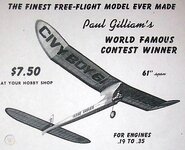OutstandingInMyField
New member
A buddy of mine who participated in FF competition in the 50's asked if there were any old-timer FF models created for RealFlight. Does anyone recall if there are? If someone tells me they're there, I'll go find them, but there seems no way to scroll through a graphic thumbnail of the models looking for a desired type.
.
.

Last edited:

